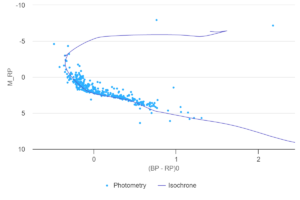NGC 2439 is a sparse, young, open cluster in the southern constellation Puppis.
A study by Eggenberger, Meynet, and Maeder (2002) found that its ratio of blue to red supergiants was in line with other clusters of similar age and position in the galaxy.
To properly analyze this cluster myself I made observations using the PROMPT-MO-1 telescope on Skynet. I made 5 observations in the B filter at 50 seconds, 5 observations in the V filter at 35 seconds, and 5 observations in the R filter at 20 seconds for a total of 15 observations. I used Afterglow to photometer, align, stack, and colour the images and Clustermancer to estimate the isochrone.
My observations align with those seen on SIMBAD. This includes a distance of 3.25 kpc and an age of 31 million years. Being a sparse open cluster the stars are quite spread out and I did not get all of them in the images so using Gaia data helped me in creating the isochrone.

Interestingly Kaltcheva, Gredel, and Fabricius (2001) published a paper claiming that NGC 2439 does not actually exist. They observe non-uniform reddening in this direction possibly suggesting a “hole” in the interstellar material of this part of the galaxy. Instead of an associated cluster we could instead be observing distinct groups of stars which fall along the same line of sight which would explain the wide difference in historical distance measurements from 1 kpc to 3.4 kpc. They propose 3 distinct groupings, close foreground stars, the four SGs group located at around 1.03 kpc, and the distant, bright background stars located at 2.6-3.2 kpc. Both of these groups show significant variance in reddening.
Having looked into this star cluster it is far more interesting than first meets the eye and with further research may yield more interesting findings about the non-uniform structure of our galaxy.